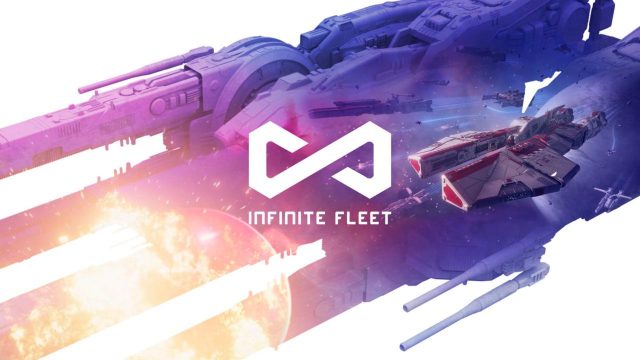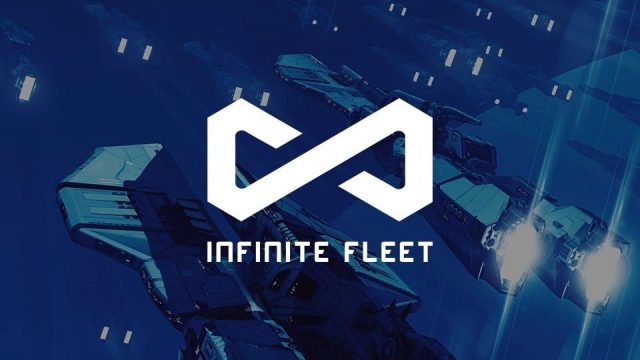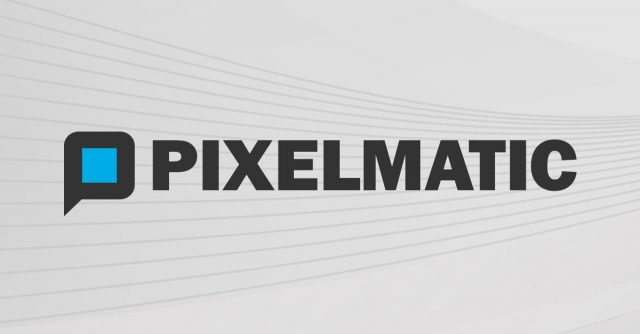This morning we talk to Pixelmatic’s CEO Samson Mow about their groundbreaking NFT Gaming technology – Infinite Fleets. Since 2011, Pixelmatic has been developing and operating games for the global market.
Powered by a veteran team that has worked on franchises such as Age of Empires, Company of Heroes, Dawn of War, Homeworld, and Mass Effect, Pixelmatic is currently working on the highly anticipated sci-fi MMO strategy game Infinite Fleet. Here is what he had to say, enjoy.
- What’s the premise behind Infinite Fleet?
Infinite Fleet is a massively multiplayer online strategy game that brings a AAA quality experience with a sidechain-augmented game economy. Each player takes control of a fleet of starships and small AI-controlled fighters to help defend humanity as part of the United Sol Federation (USF). Players explore a vast procedurally generated galaxy and defend humanity against an invading alien threat, the Atrox.
- What are Infinite Fleet NFTs and how do they function?
NFTs on Ethereum and other chains have poisoned the well, and this has turned off gamers. Most NFTs are quite laughable and confer no benefits to players other than being a marketing angle. However, if done right, NFTs could be fantastic for opening up trade in an MMO game.
If you’ve ever played World of Warcraft, you’ll know that secondary markets for the in-game gold and game items exist. The problem is that you have to trust the person you’re trading with, and when you’re working outside the terms and conditions of Blizzard, it feels like quite a sketchy territory. I’m sure a lot of people have been scammed.
Related: Ore System explains NFT Gaming
Infinite Fleet issues FTC on Liquid (a Bitcoin sidechain) and as the game currency is also a cryptoasset, you can actually trade trustlessly using atomic swaps.
This was the whole point for us to integrate NFTs and make the game currency a cryptoasset. In Infinite Fleet, the NFT acts like the key to your ship or space station. You can trade the keys with anybody, and whoever owns the key, can take control of the game item.
So, we aren’t making a metaverse. We’re simply allowing open trading for our player base and we’re not promising that NFTs are magical or that they confer permanent ownership.
Samson Mow CEO of Pixelmatic
- How have MMO games improved the mass adoption of cryptocurrencies and their affiliated technologies?
Many of the early adopters of Bitcoin were online gamers, simply because for many gamers, it was easy to understand the value and purpose of digital assets. Now, with Bitcoin and other cryptocurrencies having significant real-world monetary value, it only makes sense for many virtual game assets to become frictionlessly exchangeable with cryptocurrencies.
That said, there are a lot of skeptical gamers out there who are a bit tired of “crypto” or NFTs and it’s hard to blame them. Bots are plaguing Discord servers and altcoin projects are constantly trying to shill their tokens. Game companies that are integrating NFTs are just trying to find another way to make millions with very little thought as to what will benefit players.
Many projects force you to buy their token first or use some dApp. The user experience is really awful. Also, the games are often just poor quality rip-offs of existing games because the developers are hoping to turn a quick buck with a little upfront cost.
Infinite Fleet is different. The game is our first priority. It could exist entirely without the NFTs or the $INF token. In fact, players don’t need to know anything at all about anything “crypto” in order to simply play. They can still receive $INF tokens and trade it within our marketplace never having known they are holding crypto assets. It’s only when they want to realize the benefits that they need to start learning a little more or trade with others P2P or on other platforms.
- How has Pixelmatic changed the face of gaming?
We’re the first AAA game project building an economy this way. The game industry is massive and snowballing, but crypto projects and blockchain nonsense buzzwords turn off most players. We’re going to be the first game that bridges that gap and onboard regular players. In fact, most of our community isn’t particularly familiar with crypto at all.
Our most avid supporters are regular MMO players, and we can see them in our Discord server slowly learning about the advantages of Bitcoin and our $INF token without feeling like we’re pushing it on them.
I’ve been focusing on the $INF side of things, but Infinite Fleet is an innovative game without that. There are some fantastic features that I think will turn heads in the game industry. We have an innovative new take on real-time strategy games with our camera and control style that blends cinematic action and high-level strategy – there are no other games that feel like Infinite Fleet.
We also have our Directed Narrative feature, in which our community drives the entire plotline of the game, and our art style is unique as well. So whereas many blockchain games are essentially a cut and paste of some other games, Infinite Fleet is a whole new IP, genre, and innovation within the games industry – even without the crypto parts!
If we can reach even a fraction of the addressable market of 3.1 billion gamers globally, there’s no telling how impactful Infinite Fleet could be.
Related: New NFT Gaming P2E Gaming and Utility
- Can you explain to us with numbers how the gaming industry has increased exponentially in value?
The gaming industry is one of the fastest-growing industries in the world. It’s way bigger than the entire movies and music industries globally combined. When I was a kid, teams of 20-40 were making games; now, they’re in the thousands. A-list celebrities like Mads Mikkelson, Keanu Reeves, Mark Hamill, and loads more are joining game studios. It’s gone from pretty alternative to the mainstream.
Fortnite made 5 billion in its first year. The global gaming market was valued at around USD 173 billion in 2020, and analysts expect it to reach USD 314.4 billion by 2026. It’s astonishing how quickly this industry is growing year on year.
I also think the COVID pandemic shows just how robust the industry is. Some larger studios found their production slowed a little, and there were some delayed games, but consumers were still buying en masse. At Pixelmatic, we were already working remotely, for the most part, so we found ourselves at an advantage in this new global paradigm.
- Please can you tell us about the INF token?
$INF is a currency within Infinite Fleet. You can only earn it by playing the game. In Infinite Fleet, players will be rewarded by taking part in the game, and then they can trade digital assets without having to trust another party.
$INF is minted on the Bitcoin sidechain “Liquid,” a network created by Blockstream, one of the most respected Bitcoin infrastructure companies. This means players can trade and store digital assets outside of the game and transact however they choose. We love the idea that our players can trade freely and believe it will inspire our community and make the game more exciting.
Infinite Fleet is not like most other games that use a blockchain because it does not make money from the in-game currency. We do not sell $INF – it is only obtained by playing.
- What is Proof of Participation?
The idea is a bit of a play on Proof of Work. $INF is earned by playing. Players take part in daily challenges, weekly events, and major narrative-driven campaigns to earn more $INF. You have to participate in the game to receive this reward.
- What are the benefits of Proof of Participation?
We wanted to build an awesome community that is incentivized to take part. The idea is for a thriving universe where players are constantly building and striving to be the MVPs fighting against the enemy Atrox aliens.
- How have new business models emerged in the gaming industry with the rise of blockchain and associated technologies?
More and more game companies are getting interested, but I think the tech has to support the game. There are a lot of games trying to build on a blockchain, but that just doesn’t work. Then you have to download a plugin or download some wallet and get to buy some cryptocurrency to make your transactions. Those are all big barriers for players.
Also, most of these blockchain games are just scammy. They raise millions on a deck with some concept art and because the industry is buzzing right now, they can generate millions by giving the promise that you can earn money while playing games and then just exit scam.
Most of these gaming companies are raising through ICOs or DAOs that are unregulated, and I think that’s an unethical way to do it. Or the game collapses because the economy gets out of control, and it’s way too expensive to take part.
So the approach we’re taking in Infinite Fleet is the game currency is secondary. What we’re building is a AAA MMO strategy game. And that is the first and foremost thing. We’ve put together a team of veteran developers who worked on Age of Empires, Company of Heroes, and many other big blockbuster games.
Also, Infinite Fleet is the first-ever game project to raise money via a security token offering (STO), which in simple terms is an equity raise with the company shares issued on Liquid, a sidechain of Bitcoin. This allows for transparency, self-custody, 24/7 trading, and early liquidity for investors. It’s a regulated path that we believe is the right way to finance the project.
In a world rapidly moving from archaic traditional financial systems to open digital financial systems led by Bitcoin, we believe we are steps ahead in this transition.
- Congratulations on your recent successful STO! What’s next for Infinite Fleet?
We’re building the game! Well, we haven’t finished the STO just yet. We oversubscribed our seed round funding, and to date, we’ve raised 7.8 million USD, but we’ve still got quite a bit to clear, and we’re working with Bitfinex Securities and INX for the remaining chunk.
The beta is coming out on July 28th. And we’re very excited about that. There will be some pretty substantial graphical updates, and we’ll be releasing on a regular 2-month cycle with massive content drops. We’re building Infinite Fleet iteratively, so the game will evolve and grow for years to come. Like other MMOs, we intend for Infinite Fleet to last for decades.
- How did you get into blockchain MMO gaming?
My background has always been in the video game industry. I previously worked at Relic on the Company of Heroes and Warhammer 40,000: Dawn of War games, then I moved over to Ubisoft and drove the release of their most successful social game, Smurfs & Co, and launched a number of online games in Asia.
For a few years, I previously worked as the COO for BTCC, one of the world’s largest exchanges and mining pools. I then moved over to Blockstream as Chief Strategy Officer, which I’ve recently left to focus on nation-state Bitcoin adoption through my new company, JAN3.
So for me, gaming and Bitcoin have always gone hand in hand. After designing game economies for years, I realized there’s always been that disparity between the studios and the players who want to trade their game items. Players will always find a way to exchange their goods, so I figured, why not embrace the secondary market? Why not give power to the players and allow them to trade how they wish?
- How has Infinite Fleet brought gaming and crypto-assets together?
(Answered with the NFT and $INF sections)
- How do the INF-NFT Atomic swaps work?
Atomic swaps allow for trustless trade. So typically, if I were buying some gold in World of Warcraft, against the developer’s terms of service, I’d pay some stranger on eBay, and we’d agree to meet someplace on the game. You arrive there, and maybe it takes a little while for that person to arrive, or maybe they don’t.
With an atomic swap, each side loads up its assets. Then the trade either happens all at once or not at all. If one party fails to fulfill the order, the transaction doesn’t occur.
This is revolutionary. There’s no need to trust. It doesn’t matter what small forum or Telegram group you met another player on; you know you will get what you ordered before your NFT ship or other assets leave your wallet. It’s a revolutionary catalyst for the free market trading of digital goods.
- Please can you tell us about the free-market approach that you have adopted for Infinite Fleet? What are the benefits of this?
(answered in 13 and elsewhere)
- How is the ownership of in-game objects protected by NFTs within the Infinite Fleet ecosystem?
NFTs are simply the keys to your spaceship. Whoever owns the NFT owns the right to use that item. The technology allows for portability, so you can keep your NFTs on whatever compatible wallet or platform as you wish and trade them however you like.
We don’t claim to decentralize the ships themselves. The NFT is simply the pointer to our centralized database of ships. Our game is not decentralized, and it doesn’t need to be. We make no silly, grandiose claims of metaverses and being able to bring spaceships into World War 2 games. Games don’t need decentralization.
However, you could trade your digital item for an asset such as $INF, which could then perhaps be traded for an item in another game. That’s the goal – free markets.
- Who are the institutional investors in the Infinite Fleet project?
We have attracted some visionary investors to this project and smashed through our first funding round. When we launched the project on Simon Dixon’s popular investment platform BnkToTheFuture, we cleared over 250 thousand dollars in 24 hours – leading to the oversubscription of the round.
We’ve raised 7.8 million to date. So we have Charlie Lee, the inventor of Litecoin and a massive influencer in the tech and Bitcoin world. Max Keiser is a media personality and co-founder of El Zonte Capital with Stacy Herbert. Tether has also put in $1 million, and Polyient, a gaming VC firm, invested 500k.
Related: Upland CEO talks about NFTs in the Gaming Space
- Please can you tell us about the team of miracle workers at Pixelmatic?
Jason Lee is the Chief Creative Officer. He was previously the Lead Gameplay Designer on Age of Empires 4, one of the biggest IPs in the strategy genre. He also worked on Company of Heroes, the highest-rated strategy game on Metacritic.
Our Director of Art, Wayne Wong Chong, has 20 years of technical art experience. He’s driving our artwork to AAA standard. In fact, under his direction. Our latest concept pieces have been featured as top picks on Artstation, a go-to place for digital art.
Jordan Guinaud is our VP of engineering. He has been building, leading, and managing teams for the better part of a decade, working with massive companies such as Coca-Cola, Phillips, and TomTom and scaling engineering organizations through their funding phases.
We also onboarded Vince DiCola as a composer who wrote the soundtrack for the original Transformers 80’s movie and Rocky IV!
- How can blockchain MMO games dominate the industry?
By making great games first and putting the blockchain part as secondary. Otherwise, most of these companies are looking to make a quick buck with some pump and dump. Blockchain should not be front and center if you are serious about building games.
- How can blockchain MMOs overcome the funding issue most face?
I think the question facing companies that want to raise money is whether they want to go by the regulated or unregulated path.
There are certainly enough blockchain game companies out there surfing on buzzword waves and raising millions with very little to show for it by simply minting a bunch of tokens and writing a nice whitepaper or some pretty concept art.
However, security token offerings (STOs) are a fantastic way to take a more legit path for those who are serious.
Infinite Fleet’s public STO is like a mini-IPO and allows all professional and retail investors to access this early-stage opportunity. Traditionally, investing in early-stage businesses is reserved for the “inner circle” of VCs, private equity firms, and Wall Street, never for the general public. With our public STO, everyone will have the opportunity to back the game and become shareholders in the business, no matter what social or income class.
We worked with STOKR to launch our STO in the EU. We raised with over 1000 public investors. I think this is an exciting and innovative path for developers to consider. The team at STOKR is excellent, so if you’re thinking about launching an STO, I’d highly recommend getting in touch with them.
- Please can you tell us about the Infinite Fleet partnership with Bitfinex?
The EXO token represents non-voting equity with profit-sharing from the publisher of Infinite Fleet, Exordium Limited, and the token is fully compliant and has an ISIN number in the EU. We will soon be listing on the brand new Bitfinex Securities platform.
This fundraising method gives the game’s supporters and anyone else, whether a professional investor or not, the unique opportunity to own a share of the business and be rewarded annually with company profits should the game be successful and profitable. It allows the developer and users to be aligned on incentives, unlike traditional crowdfunding methods that see developers solicit donations from users without obligation.
- What are the problems investors face when making decisions regarding MMO games and how can they solve these problems?
You have to look at the team and their game credits. Not only that, but what did they contribute to their previously shipped titles? I’ve seen a lot of blockchain game companies claiming to have AAA devs, but then a quick look at their GitHub or game credits can be very revealing.
I’d also recommend you demand to see a prototype and play it if possible. You need to know that a product is being built, even if it’s pretty rough.
Most investors who aren’t familiar with games can easily be duped by a really nice piece of concept art or something that may have been downloaded from an asset store. A company might be using the Unreal 5 engine or something like that and showing off the mighty tech demos these engines produce, but that’s like an artist saying they are using the latest version of Photoshop; the tool is only as good as the wielder. So really, you have to see gameplay, no matter how rough it is. Even trailers can easily be outsourced and have no representation of the game.
For Infinite Fleet, we didn’t start looking for investment even from our network without having a working prototype and a game trailer that we built internally, with game assets that would actually exist in the game.
I’m building for the future, and players will love Infinite Fleet for decades.













